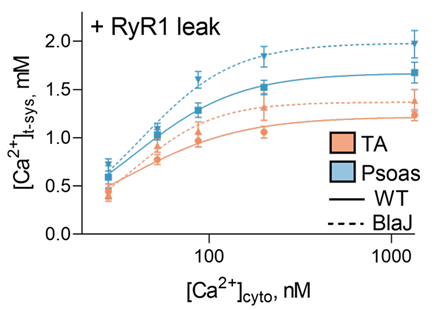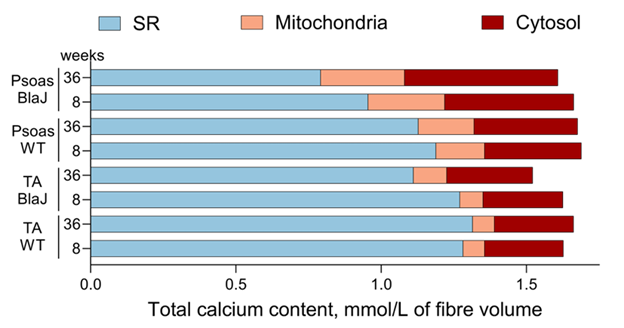Muscle-specific Ryanodine receptor 1 properties underlie limb-girdle muscular dystrophy 2B/R2 progression
Researchers at the University of Queensland, led by Dr. Bradley S. Launikonis, published a paper in the March 2025 issue of Nature Communications describing how dysferlin deficiency impacts calcium handling in skeletal muscle and how the baseline leakiness of the ryanodine receptor (RyR1) could be contributing to how and when muscles become affected when dysferlin is absent. Calcium released from RyR1 in response to nerve stimulation is the trigger for muscle contraction. However, even when muscle is at rest, the RyR1 leaks a little calcium, which serves to maintain body temperature by causing the muscle to expend energy. Since different muscles have different baseline calcium leak rates, this could account for variations in affectedness.
The researchers compared calcium leak rates between two different muscles, tibialis anterior (TA) and psoas, in both wild-type and dysferlin-deficient mice at different ages. These two muscles were chosen because the psoas muscle is strongly affected in mice with dysferlin deficiency, while the TA muscle is very mildly affected until late in the animal’s life.
The researchers made the following observations:
- The psoas had a significantly higher resting calcium leak than the TA in wild-type and dysferlin-deficient mice at both time points studied (8 weeks—presymptomatic, and 36 weeks—when the psoas but not the TA has significant pathology in dysferlin-deficient animals)
- The calcium leak increased with age in both muscles and in both wild-type and dysferlin-deficient mice
- The dysferlin-deficient mice had a higher calcium leak than the wild-type mice in both muscles at both time points (see Fig 1g)

Fig 1g: Dysferlin deficiency exacerbates intrinsic differences in RyR1 leak between psoas and TA.Steady-state [Ca2+]t-sys across a range of [Ca2+]cyto in presence of RyR1 leak in TA and psoas muscles in both WT and BlaJ mice.
From Meizoso-Huesca et al. NatCommun. 2025 Mar 28;16(1):3056)
- The RyR1 protein is more phosphorylated in the psoas than in the TA, which may account for the higher calcium leak rate (known to be influenced by phosphorylation) and point to a greater role for the psoas in maintaining body temperature
- A significant amount of calcium was sequestered in the mitochondria of the psoas muscle in the 36 week dysferlin-deficient mice. This is liable to damage the mitochondria and impact cellular metabolism and could account for the greater affectednessof the psoas (see Fig 6h)
 Fig 6h: Endogenous Ca2+ content (per fibre volume) of the major subcellular compartments in 8 and 36-weeks-old WT and BlaJ TA and psoas fibres, shown as cumulative histograms.
Fig 6h: Endogenous Ca2+ content (per fibre volume) of the major subcellular compartments in 8 and 36-weeks-old WT and BlaJ TA and psoas fibres, shown as cumulative histograms.
From Meizoso-Huesca et al. NatCommun. 2025 Mar 28;16(1):3056)
The observation that dysferlinopathy is associated with excessive calcium leakage through the RyR1 could provide a basis for the pathological mechanism of dysferlinopathy and explain why, in both mice and humans, there is significant variation in how much different muscles are affected.
Read More!
We encourage you to check out the full data and discussion of these findings. Article full text: Meizoso-Huesca A, Lamboley CR, Krycer JR, Hodson MP, Hudson JE, Launikonis BS. Muscle-specific Ryanodine receptor 1 properties underlie limb-girdle muscular dystrophy 2B/R2 progression. Nat Commun. 2025 Mar 28;16(1):3056. doi: 10.1038/s41467-025-58393-2. PMID: 40155594; PMCID: PMC11953303.
Credit: Blog post image on the following page: https://www.jain-foundation.org/category/blog/
Used with permission from Aldo Meizoso Huesca, University of Queensland















